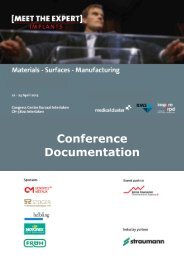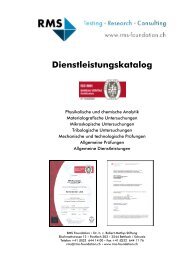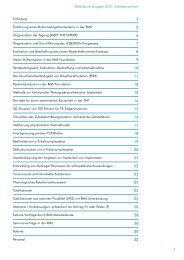RMS-Bericht 2012 - RMS Foundation
RMS-Bericht 2012 - RMS Foundation
RMS-Bericht 2012 - RMS Foundation
Create successful ePaper yourself
Turn your PDF publications into a flip-book with our unique Google optimized e-Paper software.
Kontaktwinkelmessung in der <strong>RMS</strong><br />
Contact angle measurement in the <strong>RMS</strong><br />
Der Kontaktwinkel eines Wassertropfens auf<br />
einer Oberfläche zeigt, ob diese wasserliebend<br />
(hydrophil) oder wasserabstossend (hydrophob)<br />
ist. Besitzt die Oberfläche viele polare<br />
Gruppen, so breitet sich der Wassertropfen<br />
auf dieser aus. Bei einem Kontaktwinkel von<br />
unter 45° spricht man von hydrophil. Sind<br />
weniger polare Gruppen vorhanden, so perlt<br />
der Wassertropfen auf der Oberfläche. Ab<br />
einem Kontaktwinkel von 90° spricht man von<br />
einer hydrophoben Oberfläche, ab 160° von<br />
superhydrophob. Verwendet man zusätzlich<br />
eine apolare Testflüssigkeit, beispielsweise<br />
Methyleniodid, so kann die Oberflächenenergie<br />
des Materials berechnet<br />
werden. Die Oberflächeneigenschaften<br />
sind für Implantate entscheidend,<br />
so führte ein hydrophileres Dentalimplantat<br />
zu einem schnelleren Anwachsen<br />
des Knochens1 .<br />
Seit 2010 ist die <strong>RMS</strong> im Besitz eines<br />
Kontaktwinkelmessgeräts (Abbildung<br />
oben, Surftens universal von OEG<br />
GmbH, D). Neben Kundenaufträgen<br />
wurde dieses auch für die Erforschung<br />
von Poly(HEMA-co-MMA) Kunststoffen<br />
als Stütz- und Dämpfungsimplant verwendet<br />
(Abbildung unten). Mit zunehmendem<br />
MMA-Gehalt im Copolymer<br />
änderte sich die Oberfläche von hydrophil zu<br />
hydrophob.<br />
Im Allgemeinen kann eine Oberfläche durch<br />
die Bestimmung des Kontaktwinkels schnell<br />
und einfach charakterisiert werden. Dies<br />
ist aber nur ein Aspekt in der Oberflächenanalytik<br />
und wird idealerweise durch XPS<br />
(Röntgen-Photoelektronenspektroskopie) zur<br />
Bestimmung der Oberflächenchemie und<br />
REM (Rasterelektronenmikroskopie) für die<br />
Topographie ergänzt.<br />
<strong>RMS</strong> Report edition <strong>2012</strong> – Materials / Surfaces<br />
The contact angle of a water droplet on a<br />
surface shows if this surface is hydrophilic or<br />
hydrophobic. If there are many polar groups<br />
on the surface, wetting is good and the drop<br />
spreads out on the surface. Such surfaces with<br />
a contact angle θ smaller than 45° are called<br />
hydrophilic. If there are only few polar groups,<br />
the contact angle of water will be higher.<br />
Above a contact angle of 90° such a surface<br />
is called hydrophobic. On superhydrophobic<br />
surfaces (θ >160°), the water drop balls up to<br />
a spherical shape enclosing air underneath.<br />
Applying an additional, non-polar test fluid,<br />
e.g. methylene iodide, allows calculating the<br />
surface energy of the material. For implants,<br />
surface properties are crucial for the acceptance<br />
in the body. A hydrophilic dental implant<br />
for example leads to a faster osseointegration1 .<br />
Since 2010 <strong>RMS</strong> owns a contact angle measuring<br />
device (top figure, Surftens universal<br />
from OEG GmbH, D). Besides contract work<br />
it was used to investigate poly(HEMA-co-MMA)<br />
polymers for a spacer implant (bottom figure).<br />
With an increasing MMA-fraction of the copolymer,<br />
the surface changed from<br />
hydrophilic to hydrophobic.<br />
In general, a surface can be characterised<br />
quickly by measuring the<br />
contact angle. But this is only one<br />
aspect of the surface analysis and<br />
it is ideally accompanied by XPS<br />
(X-ray photoelectron spectroscopy)<br />
for the surface chemistry and SEM<br />
(scanning electron microscopy) for<br />
the topography.<br />
1 Schwarz F. et al. Journal of Biomedical<br />
Materials Research, Part B 88, 544-557,<br />
2009.<br />
R. Heuberger<br />
J. Sague<br />
Abbildungen:<br />
Oben: Kontaktwinkelmessgerät.<br />
Unten: Kontaktwinkel von<br />
poly(HEMA-co-MMA)<br />
(poly(2-hydroxyethylmethacrylate-co-methylmethacrylate))Mischpolymeren.<br />
Figures:<br />
Top: Device for measuring<br />
the contact angle.<br />
Bottom: Contact angle<br />
of poly(HEMA-co-MMA)<br />
(poly(2-hydroxyethylmethacrylate-co-methylmethacrylate))<br />
co-polymers.<br />
11





